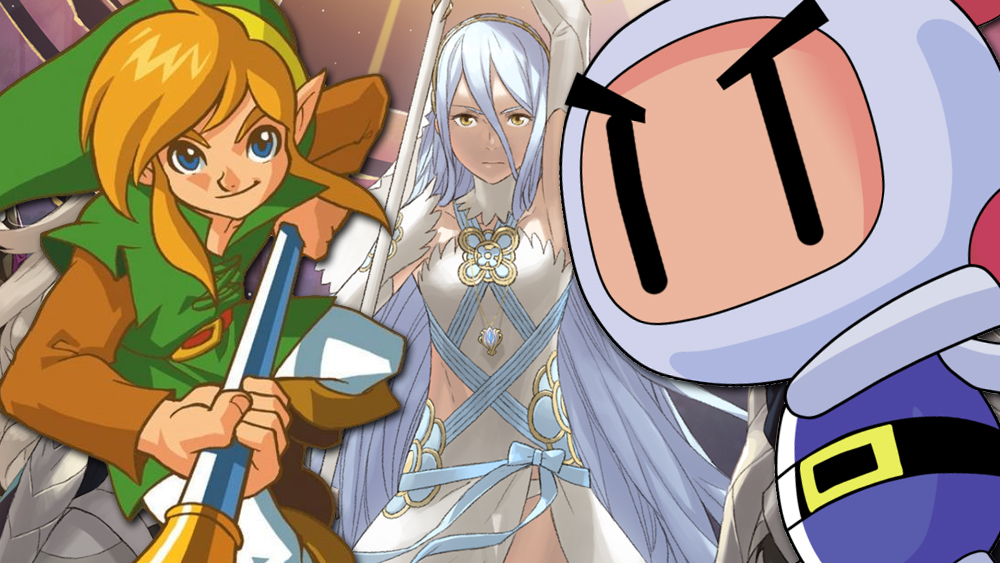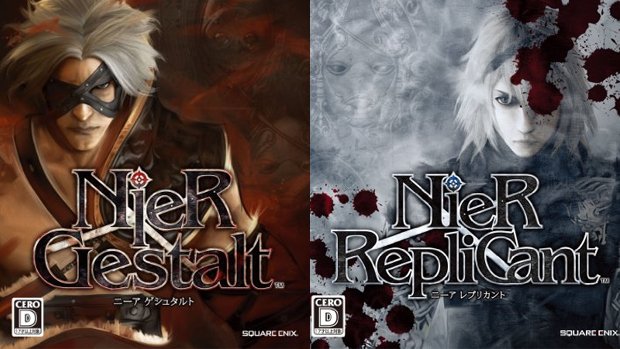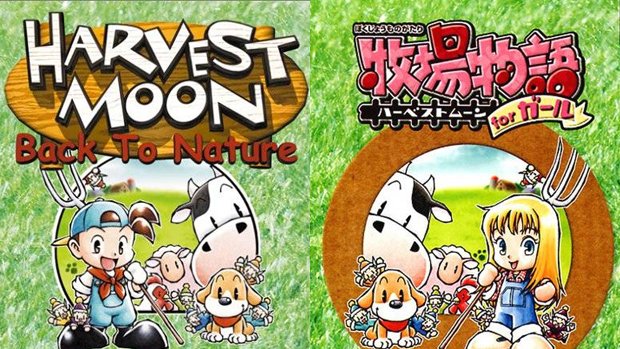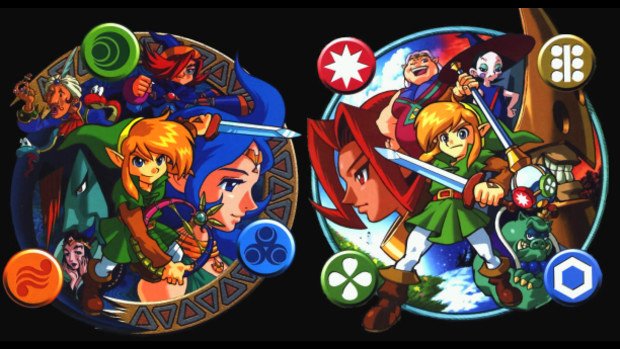One game, two versions, and not a Pokemon in sight

The rampant popularity of Pokemon's enduring dual-release format has inspired plenty of creature-collecting games to split one game into two for the sake of collectibility and extra profits. DemiKids Light and Dark, Digimon World Dawn and Dusk, Robopon Sun, Star, and Moon, Medabots: Metabee and Rokusho, Yo-kai Watch Busters: Red Cat Troupe and White Dog Corps - the list goes on and on. You've also got card-trading games built off the same model, like SNK vs. Capcom: Card Fighters Clash and the Mega Man Battle Network series. But then there are outliers like the recent Fire Emblem Fates, with its Birthright and Conquest iterations, that share the same basic gameplay yet tell two unique variants of a unifying story.
Here, the dual release format isn't used to gate off 100% completion - it frees up space for different protagonists and perspectives, an ingenious way to justify two seemingly interchangeable versions of a full-price game. Or, if nothing else, it adds some variety to some seriously unlikely series (like Bomberman, of all things). Their changes aren't always as major as the plotline split in Fire Emblem Fates, but the following games used dual releases to alter the tone and offer distinct takes on the same foundation, rather than merely parceling out a set of exclusive monsters to one game or the other.

Nier Gestalt and Replicant
Even if you've got the obscure gaming chops to know about Nier, Square Enix's post-apocalyptic spin-off from the macabre Drakengard series, you might not be aware that it exists in two distinct forms. The Nier that English speakers know is actually Nier Gestalt, Japan's Xbox 360 version of the game starring our hero Nier as a grizzled man. It was decided that Western audiences would have a stronger connection to a more mature protagonist - but for Japan's PlayStation-dominated console market, there was Nier Replicant on PS3, which depicts Nier as a lithe young boy. The variation in the protagonist's age also changes the framing of your quest: Nier is a father trying to save his daughter in the 360 version, but a brother saving his sister on PS3. The gameplay is identical between systems, but given how your quest deals with some pretty heavy concepts about family, that slight tweak in perspective could completely shape your perception of Nier's actions and emotions. I'm curious to see if the divergent narratives will somehow be explained (or at least addressed) in the upcoming PS4 sequel Nier 2.

Harvest Moon: Back to Nature and For Girl
Few games have the audacity to so bluntly target a specific gender in their title. The only other one I can think of is The Guy Game, and the less that's said about that atrocity, the better. The gender of your crop-tending, animal-raising farmer in the PS1 Harvest Moon games is determined by your version; you're a boy in Back to Nature and a girl in For Girl. And while the farming gameplay is virtually identical between the two versions, some changes to For Girl's progression structure expose some seriously antiquated ideas about womanhood. For starters, boys inherit the farm as their own; girls play an amnesiac who's permitted to live on the farm and take care of it after washing ashore from a shipwreck. Courtship is a big part of Harvest Moon life, and girls will need to work on their exclusive Beauty Stars stat if they hope to win over a bachelor's heart. Most regrettable is the fact that, while boys are encouraged to get hitched and have kids over the course of their journey, For Girl immediately ends whenever you get married. Yikes. It's no wonder why For Girl was never released outside of Japan - at least until the PSP port Harvest Moon: Boy & Girl, which bundles the two games together.

Bomberman Max: Blue Champion and Red Challenger
When most people think of Bomberman, they envision some chaotic multiplayer full of frantic explosive-dropping, devious traps, and death by self-detonation. But there's an entire line of handheld Bomberman games that take Hudson Soft's mouthless demolition man and set him in a series of single-player dungeons. And in Bomberman Max for Game Boy Color, the version you buy determines whether you play as Bomberman (Blue) or his rival Max (Red), a Protoman-esque frenemy sporting a cape and an insect-like helmet. Both have access to different Charaboms (i.e. Pokemon), Bomberman tosses fire bombs while Max uses electricity bombs, and linking up the two versions makes it much, much easier to score the good ending. If you don't have a pal with the opposite version, you'll need to finish every single stage if you're hoping to bypass the shame and emptiness of the bad finale screen: the question "END?" in giant lettering alongside a shot of your utterly perplexed protagonist.

Crash Bandicoot Purple and Spyro Orange
Who would've guessed that it would be a pair of Game Boy Advance games that would canonically unite two of PlayStation's biggest would-be mascots - a feat that not even PlayStation All-Stars: Battle Royale could manage. Granted, the original creators Naughty Dog (Crash) and Insomniac (Spyro) weren't involved; the crossover was the result of Sierra Entertainment owning the rights to both of these platforming legends at the time. The games themselves were a mix of 2D platforming and a heaping helping of top-down minigames, with each anthropomorphic animal hero warped into the other's reality after villains Dr. Neo Cortex and Ripto team up for world domination. Sure, these games don't quite recapture the 3D glory of Crash and Spyro's PS1 days, but they're not half bad - and better yet, they've got entirely unique level designs, save for the same final boss fight and a duplicate ending (unless you consider different fonts to be a significant distinction).

The Legend of Zelda: Oracle of Ages and Oracle of Seasons
Of all the dual releases that have been and ever will be, the Oracle series will no doubt go down in history as the greatest use of the format. These Game Boy Color games build off the same classic, top-down Zelda gameplay and adorable art style as Link's Awakening, depicting two unique adventures that merge into one when linked via the proper password. Both quests have everything you'd expect from a great Zelda game - challenging dungeons, quirky NPCs, empowering items - and both revolve around the manipulation of time, though Seasons works in months and Ages in years. What's astounding is that you can play both games in whatever order you like, and some secrets encourage multiple playthroughs of either or both, which creates a complex network of parallel timelines for your adventuring. It's no wonder that Capcom and Nintendo decided that the proposed trilogy of Oracle games was simply too complicated to execute properly.
Weekly digests, tales from the communities you love, and more
Lucas Sullivan is the former US Managing Editor of GamesRadar+. Lucas spent seven years working for GR, starting as an Associate Editor in 2012 before climbing the ranks. He left us in 2019 to pursue a career path on the other side of the fence, joining 2K Games as a Global Content Manager. Lucas doesn't get to write about games like Borderlands and Mafia anymore, but he does get to help make and market them.



